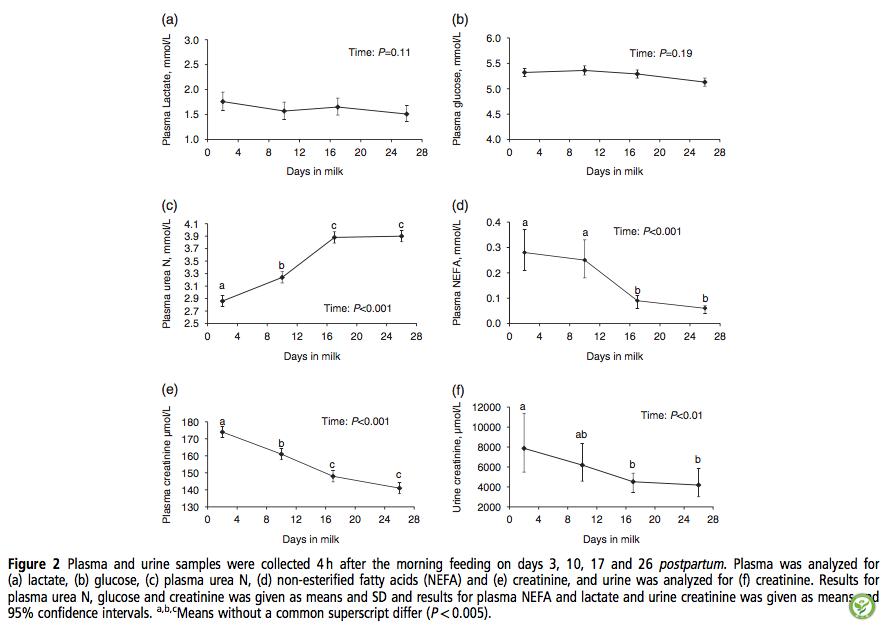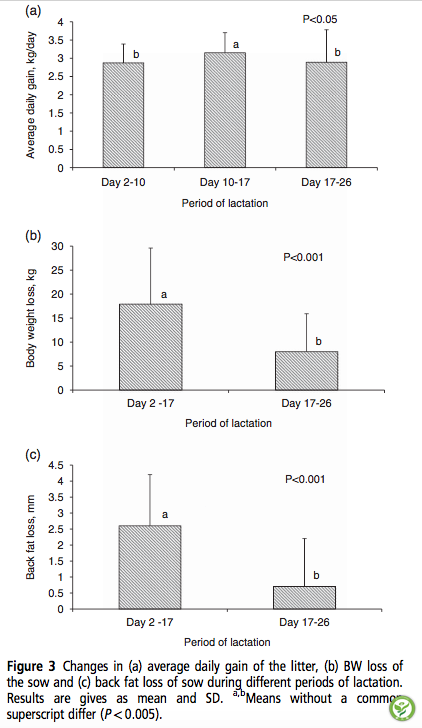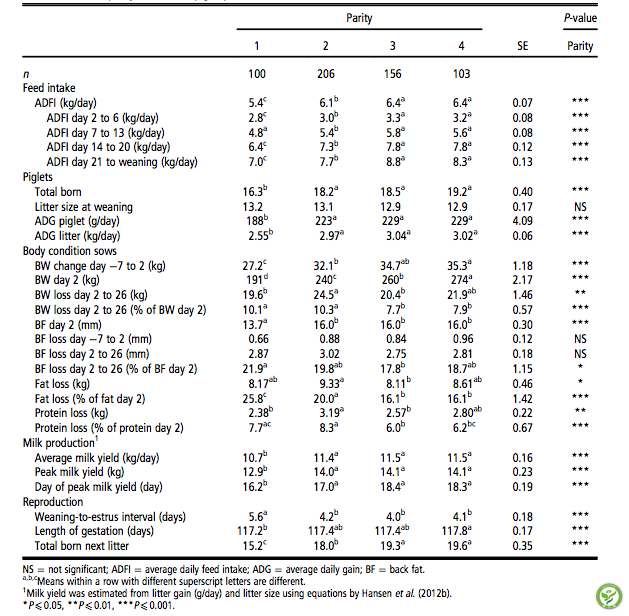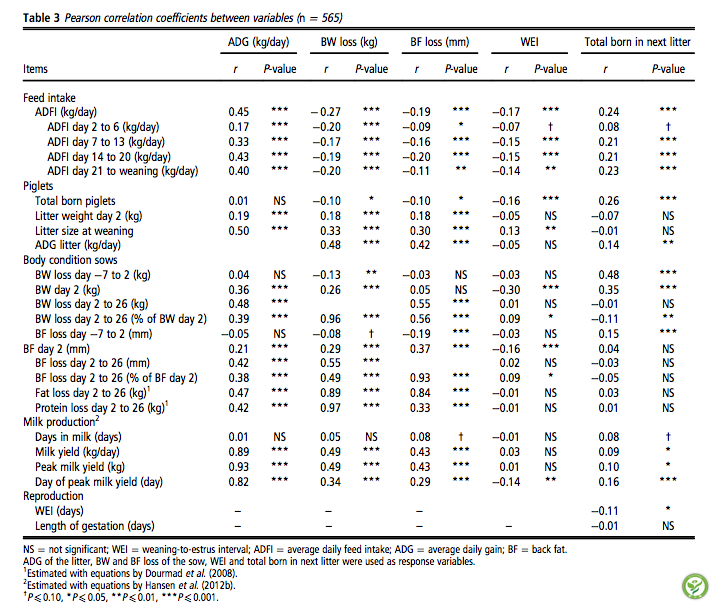当前位置:首页> >肠动力研究院> >技术文章> > 技术文章
第04期 丹麦最新母猪研究:高泌乳母猪具有高采食量和高体况损失特征
Sows with high milk production had both a high feed intake and high body mobilization
作者:A. V. Strathe1, T. S. Bruun2 and C. F. Hansen1†
1Department of Large Animal Sciences, Faculty of Health and Medical Sciences, University of Copenhagen, Grønnegaardsvej 2, 1870 Frederiksberg C, Denmark; 2SEGES Danish Pig Research Centre, Axeltorv 3, 1609 Copenhagen, Denmark
来源:Animal, page 1 of 9 © The Animal Consortium 2017 doi:10.1017/S1751731117000155
翻译:肠动力研究院
提高窝产仔数的选育工作促使高产母猪护理大群的仔猪,然而,关于现代高产母猪的泌乳量量与采食量、体况损失之间关系的知识匮乏。本研究之目的是为了确定高泌乳和护理更大群仔猪的母猪具有的特征,母猪不同胎次之间的差异,泌乳性能对下一胎次的影响。总共研究了565头母猪(1-4胎),从分娩前7天到断奶。产后2天,每窝调整到14头仔猪。在产前7天、产后2天和断奶时,测定母猪的体重和背膘。在出生第2天和断奶时,测定窝重。计算各变量之间的Pearson 相关系数,建立回归模型。母猪平均日采食量(ADFI)是6.1±1.1kg/day,窝平均平均日增重(ADG)2.92±0.53kg/day,窝平均断奶数13.0±1.1。对比第2胎和第4胎母猪,头胎母猪一般平均日采食量和泌乳量偏低,下一胎的产仔数也偏低,这也能解释头胎母猪比经产母猪要相对多地动用机体储备。窝日增重与母猪的日采食量、窝仔数和体况损失呈正相关,从1胎到4胎,整个泌乳期母猪的日均采食量增加1kg/天将增加窝日增重220-44g/天。从1胎到4胎的母猪,泌乳期的日均采食量增加1kg/天减少体重损失6.6-13kg,然而,在泌乳期,4个胎次的母猪每增加1kg/天的泌乳量将使母猪的体况损失4.3kg到21.0kg。下一胎次的产仔数与上一胎次的产仔数呈正相关。总结:高采食量和高体况损失是高泌乳量的前提;母猪的采食能力可能已经非常接近其本身采食量的极限,因此,未来泌乳高产母猪的研究应该聚焦于优化日粮的能量和日粮营养的浓度,初产母猪和经产母猪之间的差异。
关键词: 体况损失 采食量 泌乳量 繁殖 母猪
以下是实验中相关图表
表1. 哺乳料配方中的原料和日粮组成

图1 .每头母猪每日记录饲喂量,从调整窝数当天-断奶的1-4胎母猪的饲喂量(kg/天)

图2.产后第3、10、17、26天,在早晨饲喂4小时后,收集血浆和尿液样本。分析血浆的乳酸、葡萄糖、血浆尿素氮、游离脂肪酸、肌酸酐;分析尿液的肌酸酐。

图3.在泌乳不同期间,窝日增重、母猪体重损失、母猪背膘的变化

表2.胎次对母猪和仔猪性能的影响

表3.变量之间的Pearson相关系数(n=565)

表4.窝日增重、泌乳期母猪体重损失、下一胎次总出生仔猪数建立回归模型,1-4胎(n=565)

总结:头胎母猪的采食量和窝日增重偏低,下一胎次的窝产仔数偏低,很可能是因为体况损失比经产母猪更大的缘故。高采食量和高体况损失是高泌乳量的前提。低采食量导致体况损失加剧和对随后胎次的繁殖性能产生负面影响,然而,大幅度提高母猪的日采食量或许不太现实。未来泌乳高产母猪的研究应该聚焦于优化日粮的能量和日粮营养的浓度,初产母猪和经产母猪之间的差异。
鸣谢:此项目由丹麦养猪研究中心和哥本哈根大学健康和医学系资金支持。
Selection for increased litter size have generated hyper-prolific sows that nurses large litters, however limited knowledge is available regarding the connection between milk production, feed intake and body mobilization of these modern sows. The aim of the current study was to determine what characterized sows with high milk production and nursing large litters, differences between sows of different parities and effects of lactational performance on next reproductive cycle. In total 565 sows (parity 1 to 4) were studied from 7 days before farrowing until weaning. On day 2 postpartum litters were standardized to 14 piglets. Weight and back fat thickness of sows were measured at day 7 prepartum, day 2 postpartum and at weaning. Litters were weighed at day 2 and at weaning. Pearson correlation coefficients between variables were calculated and regression models were developed. The average daily feed intake (ADFI) of the sows was 6.1 ± 1.1 kg/day, average daily gain (ADG) of the litter was 2.92 ± 0.53 kg/day and sows weaned 13.0 ± 1.1 piglets. First parity sows generally had a lower ADFI and milk production and a decrease in total born piglets in next litter compared with parity 2 to 4 sows, which could be explained by a relatively higher proportion of their body reserves being mobilized compared with multiparous sows. The ADG of the litter was positively related by ADFI of the sows, litter size and BW loss and increasing the ADFI with 1 kg/day throughout lactation likely increased the ADG of the litter with 220 to 440 g/day in parity 1 to 4, respectively. Increasing the ADFI by 1 kg/day reduced the BW loss with 6.6 to 13.9 kg of parity 1 to 4 sows, respectively, during lactation, whereas increasing the average milk yield with 1 kg/day raised the BW loss with 4.3 to 21.0 kg of the four parities during lactation. The number of total born piglets in the next litter was positively related to the number of piglets born in the previous litter. In conclusion, both a high feed intake and a high mobilization of body reserves was a prerequisite for a high milk production. The sows might be very close to the physical limit of what they can ingest and future research should therefore, focus on optimizing the dietary energy and nutrient concentrations of diets for lactating hyper-prolific sows and herein distinguish between primiparous and multiparous sows.
Keywords: body mobilization, feed intake, milk production, reproduction, sow
In conclusion, primiparous sows had a lower feed intake, ADG of the litter and a lower litter size in the next reproductive cycle, which was likely caused by a higher degree of body mobilization compared with multiparous sows. Both a high feed intake and a high mobilization of body reserves were a prerequisite for a high milk production. A low feed intake increased body mobilization and had negative effects on the subsequent reproduction, although a large increase in daily feed intake is perhaps not realistic. Instead, future research should focus on optimizing the dietary energy and nutrient concentrations of diets for lactating hyper-prolific sows and herein distinguish between primiparous and multiparous sows.
Acknowledgments
The project was funded by the Danish Pig Research Centre and the Faculty of Health and Medical Sciences, University of Copenhagen.
如您需原文,请联系本文作者和出版方,或请垂询肠动力研究院。
本网站发布的所有资料将尽最大可能注明出处、作者及日期,如无意中侵犯了您的知识产权,请来信及时告知,我们将立即予以删除。
All information released by the WeChat Official Account will do its best to indicate the source, author and date. If we inadvertently infringe on your intellectual property, please inform us in time and we will delete it immediately.